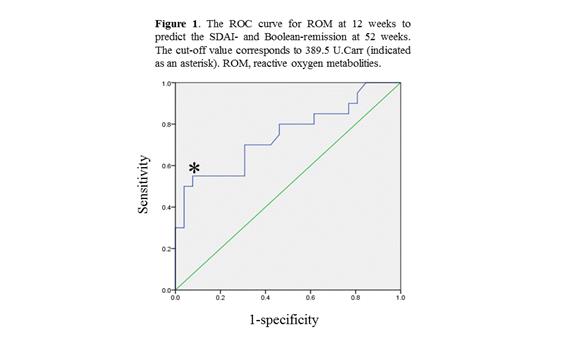Session Information
Date: Monday, November 6, 2017
Session Type: ACR Poster Session B
Session Time: 9:00AM-11:00AM
Background/Purpose: Oxidative stress induced by reactive oxygen species is thought to be an important mechanism that underlies joint destruction and synovial proliferation. We have shown that serum levels of reactive oxygen metabolities (ROM) at 12 weeks during treatment with biologic agents (BAs) are predictive for the DAS28-remission at 52 weeks. However, it has not been elucidated whether ROM is also a predictor for the CDAI-, SDAI- or Boolean-remission at 52 weeks.
Methods: Fifty-four BAs-naïve RA patients (mean age: 59.8}13.6 y, disease duration: 7.26}10.8 y) were included in this study. Association between ROM, CRP, MMP-3, DAS28, CDAI, SDAI, and HAQ at 12 weeks and the CDAI-, SDAI-, and Boolean-remission at 52 weeks was investigated. To measure ROM, the d-ROM test was performed using the FRAS4 analyzer (Wismarl, Italy). In order to identify predictor(s) for the 52-week remission, a multivariate logistic regression analysis was performed and an ROC analysis was also performed to determine their cut-off values.
Results: CDAI and SDAI at baseline was 17.8}11.6 and 20.4}13.0, respectively but decreased to 5.54}11.6 and 6.21}13.1 at 52 weeks and the remission rate for CDAI, SDAI and Boolean was 54, 57 and 56%, respectively. Significant factors at 12 weeks between the remission and non-remission group at 52 weeks were (1) ROM, DAS28, CDAI, and HAQ for the CDAI-remission, (2) ROM, DAS28, CDAI, SDAI, and HAQ for the SDAI-remission, (3) ROM, DAS28, and HAQ for the Boolean-remission (Table 1). A multivariate logistic regression analysis revealed that ROM at 12 weeks was associated with the CDAI- (p=0.032, OR: 0.991, 95%CI: 0.983-0.999), SDAI- and Boolean-remission (p=0.006, OR: 0.988, 95%CI: 0.980-0.997) at 52 weeks. ROC analyses demonstrated that AUC for the CDAI-remission was 0.702 and the cut-off value was 389.5 U.Carr (sensitivity: 52.4%, specificity: 91.7%). AUC for the SDAI- and Boolean-remission was 0.746 and the cut-off value was 389.5 U.Carr (sensitivity: 55.0%, specificity: 92.3%, Figure 1).
Conclusion: These results suggest that neither CRP nor MMP-3 can be a predictor for the remission during early stage of treatment with BAs. Instead, ROM at 12 weeks was a predictor for the CDAI-, SDAI-, and Boolean-remission at 52 weeks. Serum levels of ROM will be a useful biomarker in the current treatment strategy aiming at the early remission of RA.
To cite this abstract in AMA style:
Nakajima A, Sonobe M, Taniguchi S, Nakagawa K. Clinical Significance of Serum Levels of ROM (reactive oxygen metabolities) at 12 Weeks during Treatment with Biologic Agents As a Predictor for the 52-Week Remission [abstract]. Arthritis Rheumatol. 2017; 69 (suppl 10). https://acrabstracts.org/abstract/clinical-significance-of-serum-levels-of-rom-reactive-oxygen-metabolities-at-12-weeks-during-treatment-with-biologic-agents-as-a-predictor-for-the-52-week-remission/. Accessed .« Back to 2017 ACR/ARHP Annual Meeting
ACR Meeting Abstracts - https://acrabstracts.org/abstract/clinical-significance-of-serum-levels-of-rom-reactive-oxygen-metabolities-at-12-weeks-during-treatment-with-biologic-agents-as-a-predictor-for-the-52-week-remission/


